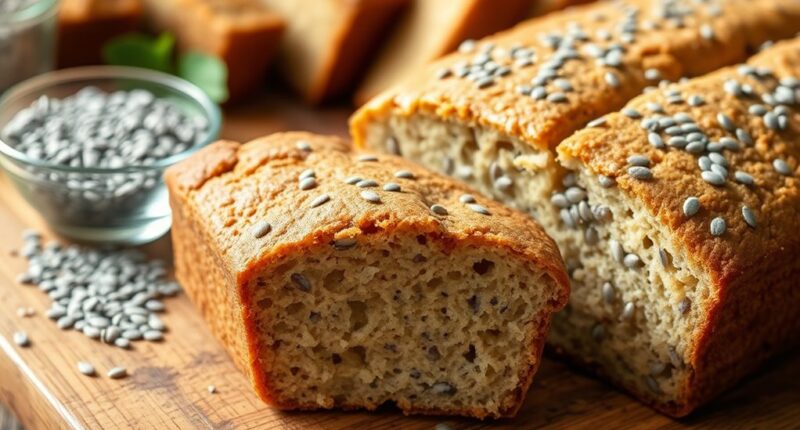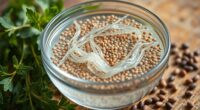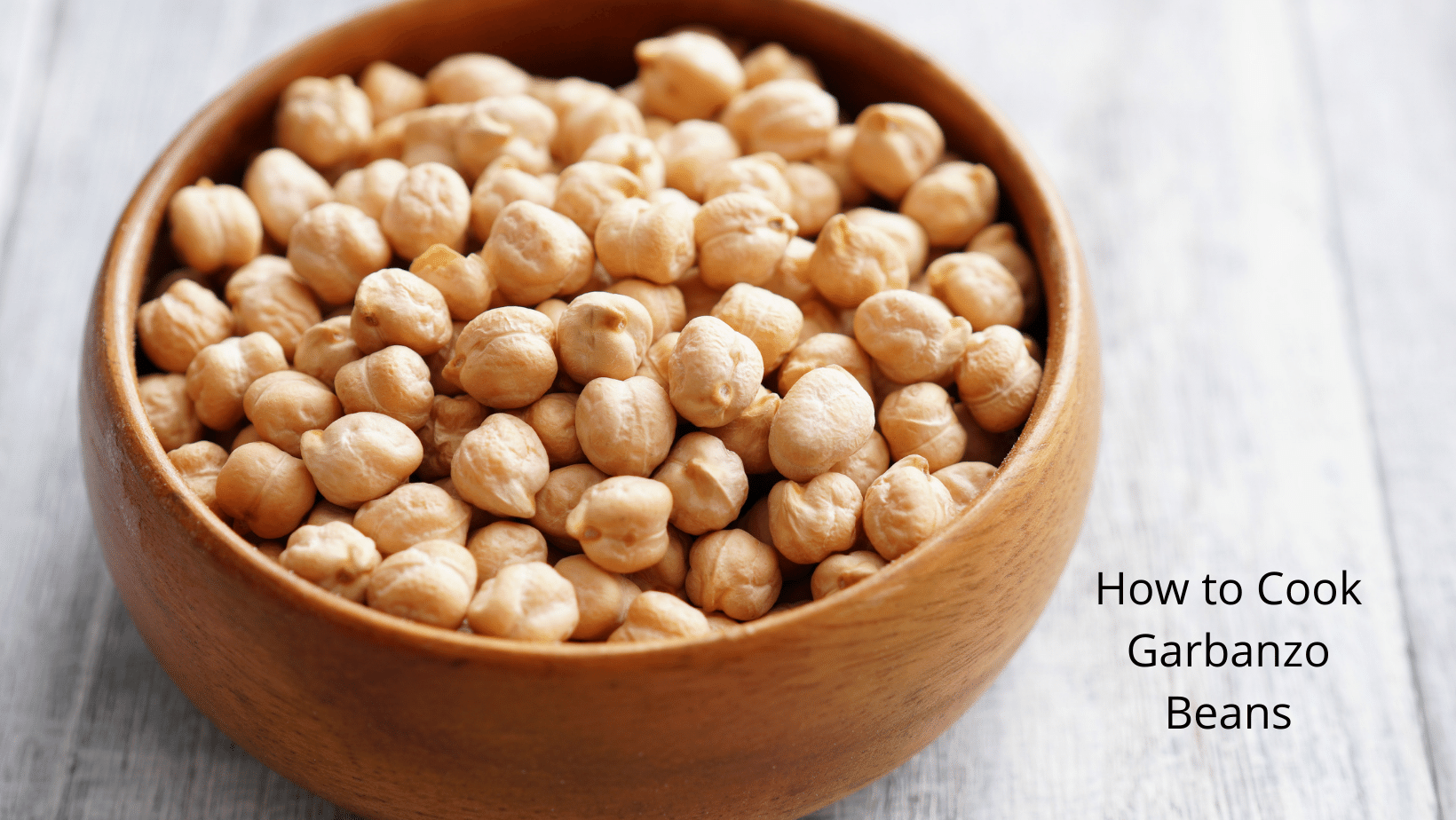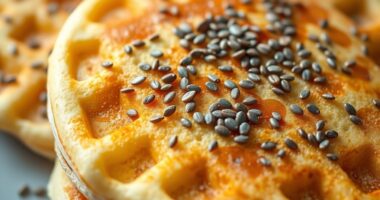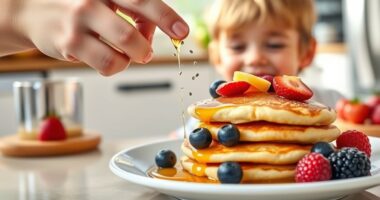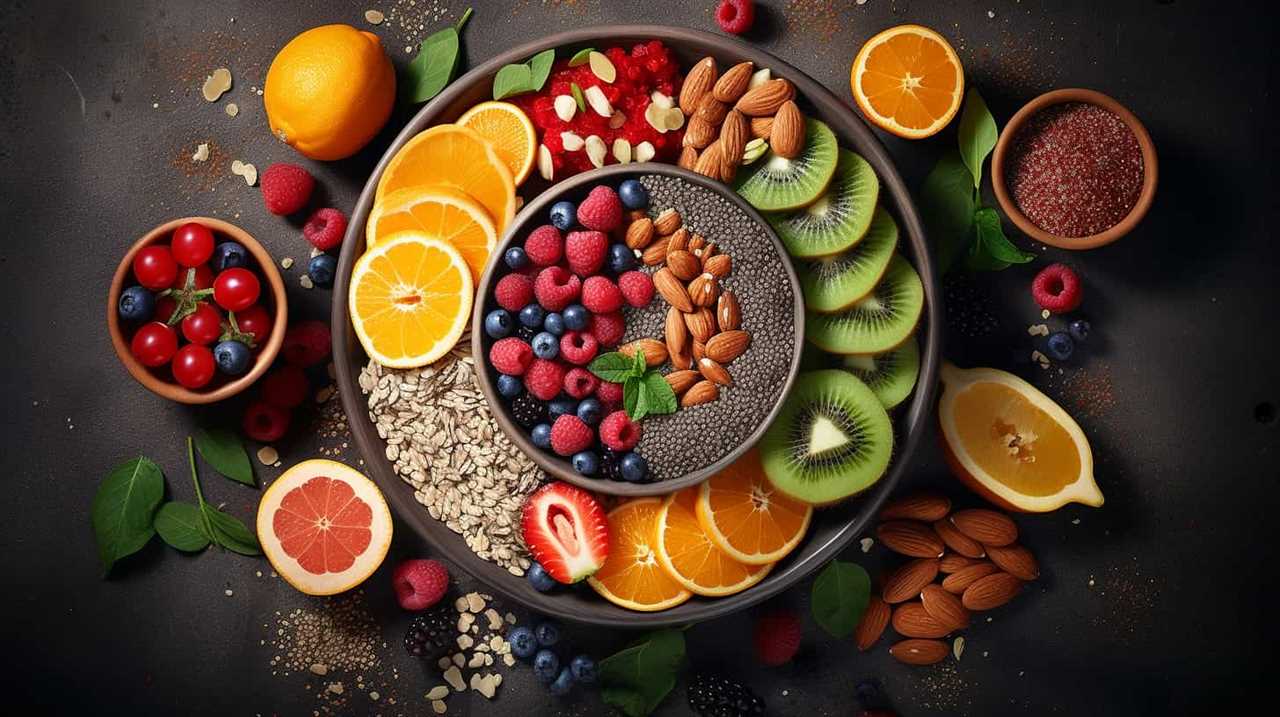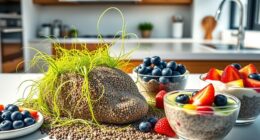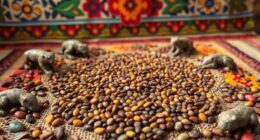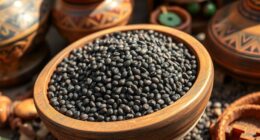To improve your gluten-free baking texture, start by soaking one tablespoon of chia seeds in water or your chosen liquid to form a gel. Incorporate this gel into your batter to boost moisture and create a flexible, elastic crumb that mimics gluten. Grinding chia seeds into powder can give a more even texture. Keep experimenting with quantities, and you’ll discover how chia seeds can make your baked goods softer and more satisfying. More tips await to elevate your baking!
Key Takeaways
- Pre-soak chia seeds to form a gel, which adds moisture and improves the elasticity of gluten-free baked goods.
- Use about one tablespoon of chia seeds per cup of gluten-free flour to enhance structure and cohesion.
- Grind chia seeds into powder for a smoother texture and more even distribution in recipes.
- Incorporate soaked chia gel directly into batters to mimic gluten’s elasticity and prevent crumbliness.
- Experiment with chia seed ratios and soaking times to achieve optimal moisture, softness, and chewiness in baked products.
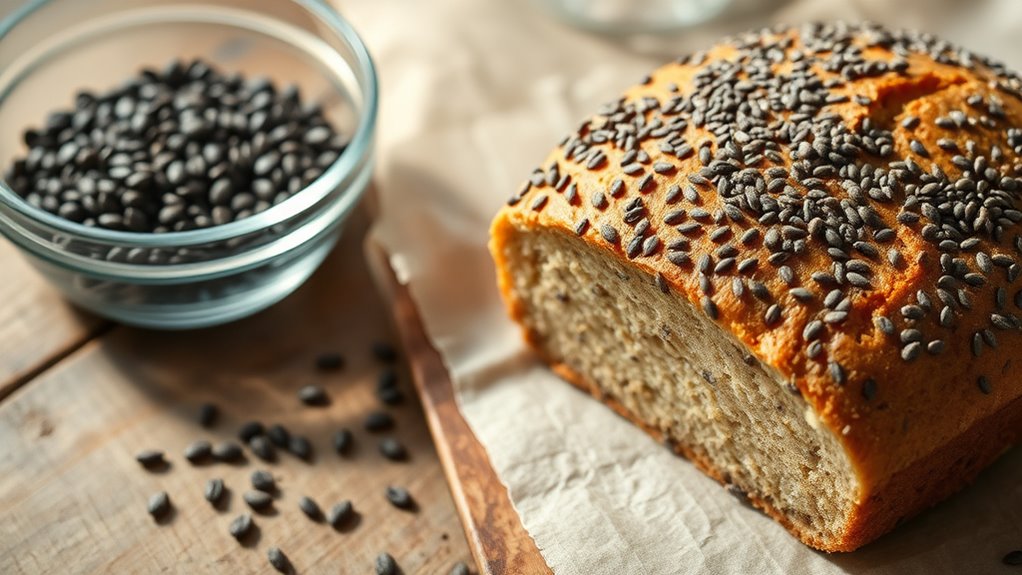
If you’re looking to enhance your gluten-free baking, chia seeds are a versatile and nutritious ingredient to contemplate. Their benefits extend beyond just adding nutritional value; they also considerably improve the texture and moisture of gluten-free baked goods. When working with gluten-free flour, which can often produce dry, crumbly results, chia seeds act as a natural binder, helping to hold everything together. This makes your baked treats more cohesive and less prone to falling apart. Incorporating chia seed benefits into your recipes can lead to softer, more elastic textures, mimicking the qualities of traditional wheat-based baked goods.
Using chia seeds is straightforward. When added to your gluten-free flour mixture, they absorb liquid and expand into a gel-like substance. This gel mimics the role of gluten, providing structure and elasticity that gluten-free flours lack naturally. To maximize these benefits, you can pre-soak chia seeds in water or other liquids before mixing them into your batter. This creates a cohesive, viscous paste that enhances the overall moisture content. As a result, your bread, muffins, or pancakes will come out with a better crumb and a more satisfying mouthfeel. Plus, this method helps prevent dryness, which is often a common issue with gluten-free baked goods.
Pre-soaking chia seeds creates a gel that improves moisture and texture in gluten-free baked goods.
Another tip to improve texture is to mix chia seeds directly into your gluten free flour. Use about one tablespoon of chia seeds per cup of flour for excellent results. This simple addition helps to mimic the elasticity of gluten, giving your baked goods a more traditional structure. The chia seed benefits don’t stop at texture; they also boost the nutritional profile by adding omega-3 fatty acids, fiber, and antioxidants. These nutrients contribute to better digestion and overall health, making your baked goods not just tastier but healthier.
Keep in mind that chia seeds can slightly alter the flavor, adding a mild nuttiness that complements many gluten-free recipes. To blend seamlessly, grind the chia seeds into a powder if you prefer a less noticeable texture. This finely ground chia can be evenly incorporated into your flour or batter, ensuring consistent results. As you experiment, you’ll find that chia seeds help produce baked goods with a tender crumb, improved moisture, and a more satisfying chew—key factors in overcoming the common pitfalls of gluten-free baking. Additionally, understanding the cost of electric baking equipment can help you plan your investment in tools that support healthier, energy-efficient baking practices. Overall, leveraging the chia seed benefits in combination with gluten free flour can elevate your baking, making your treats more enjoyable and bakery-quality.
Frequently Asked Questions
Can Chia Seeds Replace Eggs in Gluten-Free Recipes?
You can use chia seeds as egg replacement techniques in baking. Chia seed substitutes work well because they form a gel when soaked in water, mimicking eggs’ binding properties. To replace one egg, mix 1 tablespoon of chia seeds with 3 tablespoons of water and let it sit until it thickens. This method is especially effective in gluten-free recipes, helping you achieve better texture without eggs.
How Do Chia Seeds Affect the Shelf Life of Baked Goods?
Think of chia seeds like tiny guardians for your baked goods, helping them stay fresh longer. They can slightly extend shelf life and improve mold resistance by retaining moisture and creating a barrier against spoilage. While they won’t drastically prolong freshness, adding chia seeds can be a smart move to help your gluten-free treats stay delicious a bit longer, especially if stored properly. Just don’t expect miracles; they’re more like helpful allies.
Are There Specific Gluten-Free Flours That Work Best With Chia Seeds?
You’ll find that certain gluten-free blends work better with chia seeds, especially those rich in rice, tapioca, and potato starches, which help improve texture. Experiment with seed combinations like chia and flax for added moisture and binding. These blends create a more cohesive batter, making your baked goods tender and less crumbly. By choosing the right gluten-free flours and seed mixes, you’ll achieve better results every time.
What’S the Ideal Chia Seed to Liquid Ratio for Baking?
Imagine chia seeds as tiny sponges—when you add liquid, they swell and form a gel. For baking, aim for a chia seed to liquid ratio of about 1:6 or 1:8. This balance ensures ideal chia seed hydration and liquid absorption, giving your batter the right consistency. Too little liquid leaves seeds dry; too much creates a runny mixture. Adjust based on your recipe for perfect texture.
Can Chia Seeds Improve the Texture of Dense Gluten-Free Breads?
Chia seeds can considerably improve the texture of dense gluten-free breads. You’ll notice better texture enhancement as they create a gel-like consistency that adds moisture retention. This helps the bread stay moist longer and improves overall crumb structure. By incorporating chia seeds, you make your bread softer and less crumbly, giving it a more satisfying, airy feel. Just guarantee you use the right amount to avoid making the bread overly dense or gummy.
Conclusion
By incorporating chia seeds into your gluten-free baking, you enhance texture, improve moisture, and boost nutrition. Embrace these versatile seeds to add structure, retain freshness, and elevate flavor. With chia seeds, you create baked goods that are not only healthier but also more satisfying. So, experiment, adapt, and enjoy the process—because better texture, better taste, and better baking all come from your willingness to try something new. Ultimately, chia seeds transform your baking into a delightful, nourishing experience.
